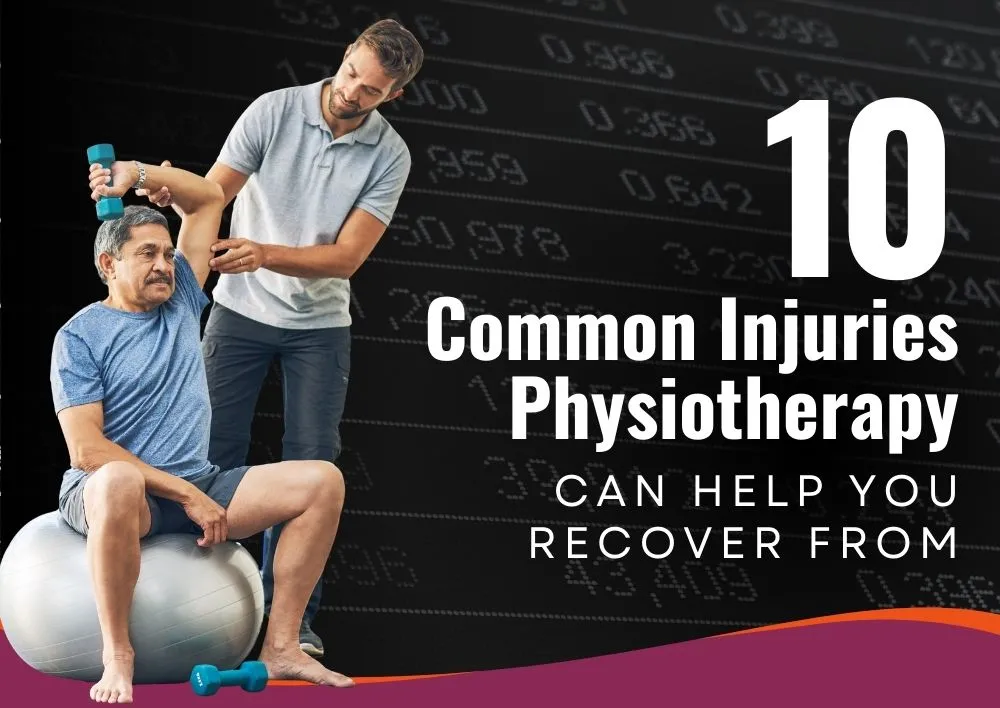10 Common Injuries Physiotherapy Can Help You Recover From
Summary
Overview
Injuries can happen anytime, whether you are an athlete, a working professional, or simply doing daily household tasks. Pain, swelling, stiffness, or restricted movement are often the first signs that something is not right. With the right treatment plan, physiotherapy not only accelerates recovery but also helps prevent long-term complications.
In this blog, we will explore 10 common injuries physiotherapy can help you recover from, along with how it benefits your overall mobility and health.
1. Sprains and Strains
One of the most common injuries treated in physiotherapy is a sprain or strain. A sprain occurs when ligaments are overstretched or torn, while a strain affects muscles or tendons. These usually happen because of sudden twists, falls, or overuse.
Dr. Surender Mor, a leading physiotherapist in Gurgaon at Miracles Mediclinic, says, "Sprains and strains may seem minor initially, but if not treated properly, they can lead to chronic pain or repeated injuries. Physiotherapy helps not just in reducing pain, but also in restoring strength and preventing future issues."
How physiotherapy helps:
Reduces pain and swelling through manual therapy and modalities like ultrasound.
Strengthens the affected muscles and ligaments to prevent recurrence.
Restores flexibility and range of motion.
2. Fracture Recovery
Fractures can take weeks or months to heal, and muscles around the injured area usually become weak during immobilization.
How physiotherapy helps:
-
Guides safe exercises to rebuild strength.
-
Prevents stiffness and improves joint mobility.
-
Helps you return to normal activities faster with minimal complications.
3. Sports Injury
Athletes usually face injuries like torn ligaments, tendonitis, or muscle tears. Improper warm-ups, high-impact sports, or repetitive strain are common causes.
How physiotherapy treatment helps:
-
Customized rehabilitation plans for safe return to sport.
-
Improves balance, endurance, and flexibility.
-
Focuses on injury prevention with sport-specific training.
4. Back and Neck Injuries
Sedentary lifestyles, poor posture, or sudden accidents often lead to back and neck injuries. Conditions like slipped disc, sciatica, or whiplash are frequent.
How physiotherapy helps:
-
Relieves pain using techniques like heat therapy, traction, or mobilization.
-
Corrects posture and strengthens supporting muscles.
-
Reduces risk of chronic pain or further injury.
5. Shoulder Injuries
Rotator cuff tears, frozen shoulder, or dislocations are some of the most painful shoulder injuries. They can limit arm movement and daily activities.
How physiotherapy helps:
-
Restores mobility with gentle exercises and stretches.
-
Builds muscle strength to stabilize the shoulder joint.
-
Prevents stiffness and improves functional use of the arm.
6. Knee Injuries
From ligament tears (ACL, MCL) to meniscus injuries, knee problems are very common, especially among athletes and elderly people.
How physiotherapy helps:
-
Strengthens supporting muscles like the quadriceps and hamstrings.
-
Improves joint stability and reduces pain.
-
Helps in post-surgery recovery after procedures like knee replacement or arthroscopy.
7. Ankle Injuries
Twisted ankles, ligament sprains, and Achilles tendon injuries commonly occur during running, jumping, or even simple missteps.
How physiotherapy helps:
-
Promotes faster healing with balance and mobility exercises.
-
Improves proprioception (joint awareness) to avoid future sprains.
-
Restores full strength and function for walking or sports.
8. Post-Surgical Rehabilitation
After surgeries such as joint replacement, ligament repair, or spinal procedures, the body requires structured rehabilitation.
How physiotherapy helps:
-
Reduces stiffness and pain after surgery.
-
Improves circulation for faster tissue healing.
-
Helps patients regain independence and confidence in movement.
9. Wrist and Elbow Injuries
Conditions like tennis elbow, carpal tunnel syndrome, or wrist sprains are common in people who use computers, play sports, or perform repetitive tasks.
How physiotherapy helps:
-
Utilizes techniques such as ultrasound therapy and manual mobilization.
-
Strengthens forearm and wrist muscles to reduce strain.
-
Teaches ergonomic adjustments to prevent recurrence.
10. Hip Injuries
Hip fractures, labral tears, or bursitis often affect mobility, especially in older adults. If left untreated, hip fractures can lead to chronic pain.
How physiotherapy helps:
-
Improves hip joint stability with strengthening exercises.
-
Enhances balance to prevent falls in elderly patients.
-
Promotes safe walking patterns with gait training.
Why Choose Physiotherapy for Injury Recovery?
Physiotherapy is not just about relieving pain; it is about restoring complete function. Unlike painkillers that only mask discomfort, physiotherapy targets the root cause of the problem. Here is why it is effective:
-
Non-invasive treatment: No surgery or medications required.
-
Personalized care: Every recovery plan is tailored to your injury and lifestyle.
-
Long-term prevention: Focuses on strengthening, mobility, and avoiding future injuries.
Conclusion:
Whether it is a minor sprain or a major post-surgical recovery, physiotherapy plays an important role in helping you heal, regain strength, and return to your normal routine. If you are struggling with pain or mobility issues, don’t ignore the signs; early treatment leads to faster recovery. Looking for an expert physiotherapist near you? Book an appointment today and take the first step towards a pain-free, active life.
Frequently Asked Questions
Physiotherapists treat musculoskeletal, sports, post-surgical, joint, ligament, muscle, and soft tissue injuries.
It reduces pain, restores strength and mobility, improves flexibility, and prevents future injuries through targeted exercises and therapy.
Physiotherapy speeds up healing, restores function, improves quality of life, and supports a safe return to daily activities or sports.
Miracles Mediclinic offers expert physiotherapy treatment in Gurgaon with personalized care, advanced techniques, and effective injury recovery programs.














Was the information useful?
0 0